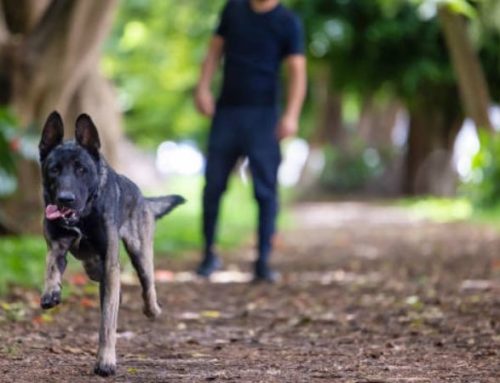If your normally sleek and spry cat has started filling out around the middle, you might be wondering whether kittens are on the way. Pregnancy in cats is a fascinating process—shorter than you might expect, but full of changes worth knowing about.
In this guide, Nexus-Pets takes you through how long cats stay pregnant, what to expect at each stage, and how you can support your feline as she prepares for motherhood.
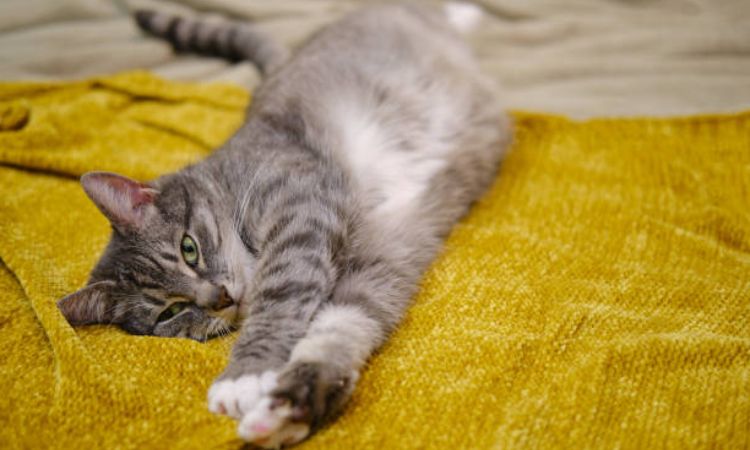
How Long Are Cats Pregnant?
The typical gestation period for a domestic cat lasts about 63 to 65 days, which is roughly nine weeks or just over two months. Most cats give birth within this timeframe, but the length of pregnancy can vary slightly depending on several factors.
- Range of pregnancy: While 63–65 days is average, some cats may carry their kittens for as few as 60 days or as long as 67 days, and in rare cases, up to 72 days.
- Factors influencing gestation length: The number of kittens in the litter, the age of the mother (queen), her overall health, and breed can all impact how long the pregnancy lasts. For instance, first-time mothers and older queens may experience slightly longer pregnancies, while litter size can affect the timing of delivery.
Understanding this timeline can help cat owners prepare for their queen’s labor, ensure proper prenatal care, and anticipate when kittens are likely to arrive.
Feline Pregnancy Stages
Pregnancy in cats typically lasts 63 to 65 days (about nine weeks) and can be divided into three main stages, each marked by distinctive physical and behavioral changes.
Early Stage (Weeks 1–3)
- Fertilization and embryo development: Pregnancy begins with conception, when the fertilized eggs travel to the uterus and the placenta starts forming. Organ development also begins at this stage.
- Minimal outward signs: Most cats show few, if any, visible changes early on.
- Subtle behavioral or physical changes: Some cats may display a slight increase in appetite, mild morning sickness, and a more affectionate or docile demeanor. Early detection is challenging, so a vet visit is recommended if pregnancy is suspected.
Mid Stage (Weeks 4–6)
- Physical changes become noticeable: The cat’s abdomen starts to enlarge, and the nipples darken and “pink up” as mammary tissue develops.
- Increased appetite and weight gain: The queen may begin eating significantly more to support the growing kittens.
- Vet check recommended: Around this stage, a veterinary visit can confirm pregnancy via palpation or ultrasound and provide guidance on nutrition, parasite control, and overall care.
Late Stage (Weeks 7–9)
- Maximum abdominal growth: The cat’s belly reaches its largest size as kittens continue to develop.
- Prominent nipples and mammary changes: Nipples are highly visible, and some milk may begin to leak as the body prepares for nursing.
- Behavioral changes: Cats often display nesting behavior, seeking quiet, secluded areas to give birth. Appetite may temporarily decrease shortly before labor.
- Labor preparation: As delivery approaches, watch for signs such as restlessness, pacing, and increased grooming. Labor usually occurs around day 63–65, though it can occasionally happen a few days earlier or later.
Understanding these stages helps cat owners provide proper care, nutrition, and monitoring, ensuring a healthy pregnancy and safe delivery for both mother and kittens.
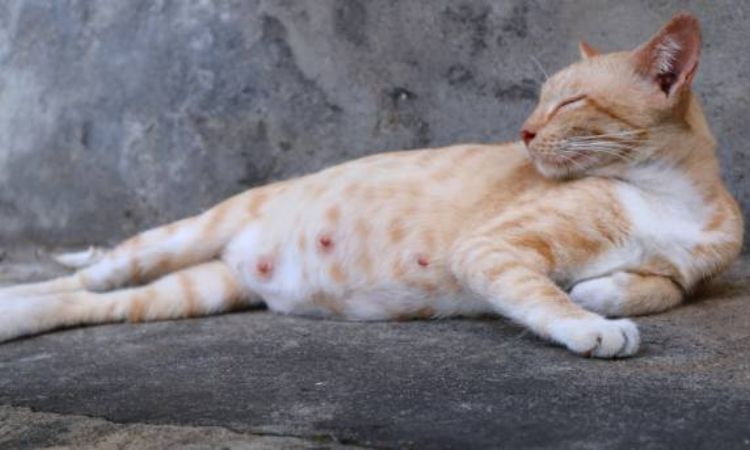
Pregnancy Signs and Detection
Detecting pregnancy in cats can be subtle during the early stages, but there are a few key signs to watch for. In the first two to three weeks, you may notice slightly swollen or pink nipples, a mild increase in weight, and changes in behavior, such as your cat becoming more affectionate or unusually calm.
By around three weeks into the pregnancy, physical changes become more apparent. The abdomen may start to enlarge slightly, and nipple changes may be more pronounced, a process often referred to as “pinking up.” At this stage, a veterinarian can confirm pregnancy using methods such as:
- Palpation: Gently feeling the abdomen to detect the presence of fetuses, usually possible after 17–21 days.
- Ultrasound: Detecting embryos and heartbeats, typically effective from 3–4 weeks of gestation.
- X-ray: Used after 6 weeks, when fetal skeletons have calcified, to determine the number of kittens and estimate the due date.
Monitoring these early signs and seeking veterinary confirmation is crucial for providing proper care and ensuring a healthy pregnancy for your cat.
Preparing for Birth
As your cat approaches the final weeks of pregnancy, she will begin exhibiting nesting behavior. This often includes searching for quiet, secluded areas, increased grooming of her belly and genital area, and arranging bedding or blankets in preparation for her kittens. Nesting is a natural instinct that helps her feel safe and secure for labor.
To support your pregnant cat, it’s important to create a comfortable, safe birthing environment. Provide a clean, warm, and quiet space, such as a cardboard box or covered cat bed lined with soft towels or blankets. Ensure the area is away from drafts, loud noises, children, and other pets, while still allowing you to monitor her from a distance.
Having a properly prepared nesting area not only reduces stress for the mother cat but also promotes safe delivery and healthy kittens. Regular observation is recommended, but avoid excessive interference unless complications arise.
Cat Labor and Birth
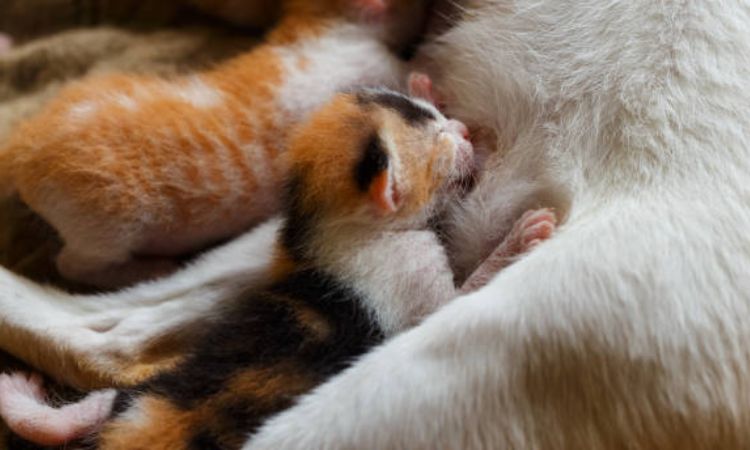
First Stage: Early Labor
- During the initial stage of labor, a cat may show restlessness, pacing, excessive vocalization, and nesting behavior.
- She may groom herself frequently, especially around the vulva, and eat less than usual.
- This stage can last 6–12 hours, during which the birth canal relaxes and the kittens move into the correct position for delivery.
Active Labor: Kitten Delivery
- Strong contractions and straining begin as the kittens start to pass through the birth canal.
- The first kitten is usually born within 30 minutes of active labor starting. Subsequent kittens generally arrive every 10–60 minutes.
- Kittens are typically born inside a thin amniotic sac, which the mother tears open to help them breathe.
- After each kitten, the placenta (afterbirth) is expelled, usually within 15 minutes, though the order is not always perfect.
- Both head-first and breech (tail-first) births are considered normal.
- Overall, the entire labor process typically takes 4–16 hours, depending on litter size and the mother’s condition.
Monitoring for Complications
- Keep a close eye on your cat throughout labor. Contact your veterinarian if you notice:
- Straining for 20–30 minutes without delivering a kitten
- Excessive bleeding or unusual vaginal discharge (e.g., green)
- Signs of distress or exhaustion
- Stuck kittens or difficulty tearing the amniotic sac
- Quick veterinary intervention can prevent serious complications and ensure the safety of both mother and kittens.
Postnatal Care
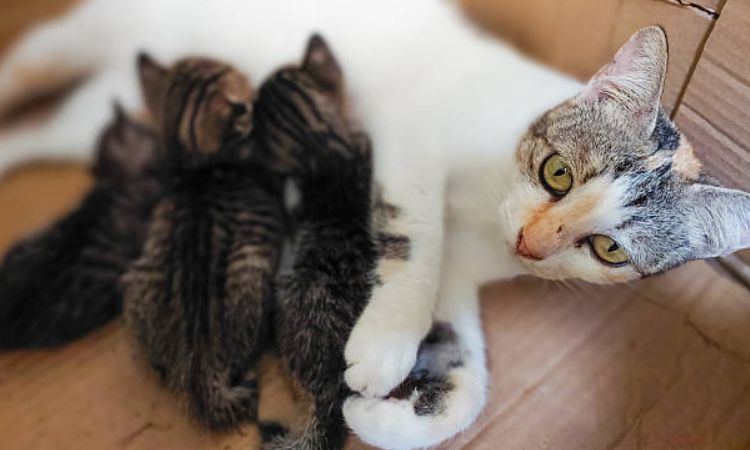
Immediate Care by the Mother
- After delivery, the mother cat usually cleans each kitten, removing the amniotic sac and licking them to stimulate breathing and circulation.
- She will begin nursing her kittens right away, providing essential colostrum that contains antibodies crucial for the kittens’ immune system.
- The mother may rest frequently between nursing sessions but generally stays close to her litter, keeping them warm and safe.
Environmental Considerations
- Ensure the kittens and mother are kept in a quiet, warm, and safe space free from disturbances.
- Bedding should be clean, dry, and comfortable, with easy access for the mother to move around without stepping on her kittens.
- Maintain a stable room temperature, avoiding drafts, as newborn kittens cannot regulate their body temperature.
Veterinary Check
- A veterinary examination within 24 hours of birth is recommended to confirm the health of both the mother and her kittens.
- The vet can check for:
- Retained placentas or membranes
- Signs of infection or hemorrhage in the mother
- Any health issues in the kittens, such as congenital defects or failure to thrive
- Follow-up care may include deworming, vaccination planning, and guidance on proper nutrition for the nursing mother.
Ongoing Monitoring
- Observe the mother for signs of stress, illness, or rejection of kittens.
- Ensure all kittens are nursing well and gaining weight daily.
- Maintain frequent feeding, hydration, and gentle handling of the mother to support her recovery and milk production.
And there you have it—a comprehensive look at the fascinating journey of feline pregnancy. From the first signs of a pregnant cat to the final moments of birth, understanding this process is key to providing the best care for your furry friend. By knowing what to expect, you can ensure a safe and comfortable environment for both the mother and her future kittens.




